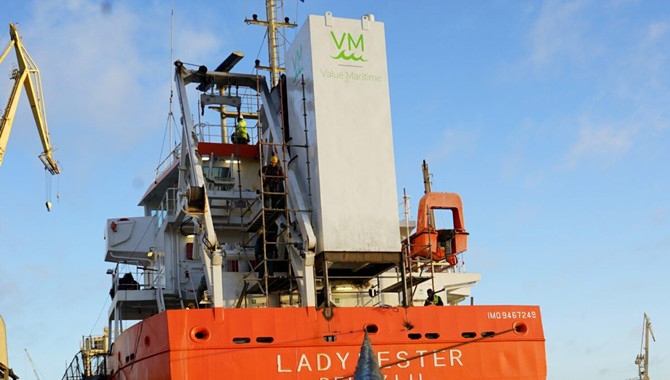
Value Maritime has modified an exhaust filtering system to collect carbon dioxide from emissions onboard ships.
Shipping companies are trying to reduce emissions, but the long life cycles of ocean vessels along with technological and supply constraints for sustainable fuels are leaving them with limited options.
Value Maritime developed a system to filter out sulfur and ultrafine air pollutants to comply with the International Maritime Organization's 2020 regulations. The regulations require shippers to either use very low sulfur fuel oil (VLSFO) or scrubbers to take sulfur and other pollutants out of ships' emissions.
Value Maritime designed the Filtree System as a cost-effective alternative to a scrubber. It is also one-third the size of a conventional scrubber, making it suitable for use on small and large vessels.
The Rotterdam, Netherlands-based company modified its Filtree System so that, in addition to filtering out sulfur, it captures carbon dioxide emissions onboard ocean vessels. Shipping companies can now purchase or lease systems that capture carbon dioxide and store it in what the company calls “CO2 batteries.”
The Filtree System is running on 12 vessels, and one vessel has the carbon-capture technology onboard, according to Maarten Lodewijks, director and co-founder of Value Maritime. Five additional carbon dioxide capturing systems have been ordered, and two of them are scheduled to be deployed in March.
How do CO2 batteries work?
Visser Shipping's Nordica vessel was the first ship to be equipped with Value Maritime's carbon dioxide capturing technology in October 2021. Value Maritime's CO2 Capture Module was added to its exhaust cleaning system. This module captures carbon dioxide and sends it to a CO2 battery onboard. The CO2 batteries are the size of 20-foot shipping containers, so they are easy to transport.
Once the vessel is docked, the full CO2 batteries are replaced with empty ones for the next voyage, and the full batteries are sent to greenhouses nearby in the Netherlands, where they use carbon dioxide as an input to grow flowers and crops. Value Maritime provides the carbon capture, storage and transportation services from vessels to greenhouses and back.
Lodewijks said the Nordica has two CO2 batteries onboard and they can hold enough carbon dioxide to reduce the ship's carbon emissions by 70%.
He said since Value Maritime shared the news of the carbon dioxide capturing and launch of the Nordica, “we have a lot of leads and a lot of contracts upcoming, and it's all with the possibility to start capturing carbon.”
Lodewijks said the system should eventually have the capability to capture 90% to 100% of carbon emissions from vessels. But it depends on how much cargo space the shipper is willing to trade for CO2 batteries and how much they are willing to pay.
“We're also looking at newbuilds where we include the battery technology within the vessel itself, so you can store more carbon dioxide on your vessel without having any cargo implications,” Lodewijks said.
Cost, payback period and potential
Value Maritime charges its customers based on how much carbon dioxide it captures, which can limit how much companies decide to reduce their emissions.
“It's a money thing. In the end, everybody wants green, but not everybody wants to pay for it,” Lodewijks said. “Customers say, ‘We want zero emission.’ But if you say, ‘Great, we can do it today but it costs you X amount of carbon reduction we capture,’ then most of them will not do that.”
Customers are becoming more willing to spend the money to reduce emissions, but it's a slow process. “That’s why you need legislation. That's why you need taxation to give something like this an additional push,” Lodewijks said.
Because the Filtree System filters out sulfur, it allows shippers to use heavy fuel oil, which is much cheaper than VLSFO. The savings due to operating on less expensive fuel typically leads to a payback period of one to three years after purchasing the system, according to Lodewijks.
He said it's likely that shippers will offer customers the option to reduce emissions along their supply chains. Customers would then pay for the system through the price shippers set for that service. Charging companies upstream to reduce shipping-related emissions could be more effective at reducing emissions than if those companies purchase carbon offsets, which have varying levels of reliability and effectiveness.
Lodewijks said this system has the potential to significantly reduce vessels' carbon emissions while shippers wait for more sustainable fuels to become available.
Value Maritime's system is plug and play, so it can be removed from one vessel and installed on another. This allows shippers to invest in emissions-reduction technology without committing to a specific fuel or vessel type for years.
It can also be installed on vessels that run on liquefied natural gas or methanol. The captured carbon dioxide could eventually go toward producing e-methanol to form a more closed-loop system.
“Our mailbox exploded, so there is a lot of interest and commercially of course, it's very good to see, but it's also cool because I think it's a great solution in the short run to really make an impact,” Lodewijks said.
Source: Freight Waves
The opinions expressed herein are the author's and not necessarily those of The Xinde Marine News.
Please Contact Us at:
media@xindemarine.com


 Ningbo Containerized Freight Index Weekly Commentar
Ningbo Containerized Freight Index Weekly Commentar  Ningbo Containerized Freight Index Weekly Commentar
Ningbo Containerized Freight Index Weekly Commentar  Ningbo Containerized Freight Index Weekly Commentar
Ningbo Containerized Freight Index Weekly Commentar  BIMCO Shipping Number of the Week: Bulker newbuildi
BIMCO Shipping Number of the Week: Bulker newbuildi  Ningbo Containerized Freight Index Weekly Commentar
Ningbo Containerized Freight Index Weekly Commentar  Ningbo Containerized Freight Index Weekly Commentar
Ningbo Containerized Freight Index Weekly Commentar